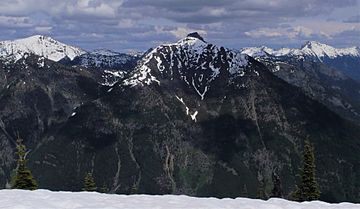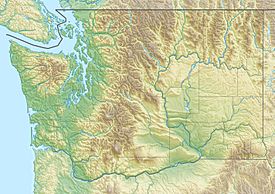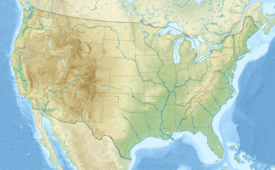Skagit Peak facts for kids
Quick facts for kids Skagit Peak |
|
|---|---|

West aspect, from Desolation Peak
(Joker Mountain left, Three Fools Peak right) |
|
| Highest point | |
| Elevation | 6,824 ft (2,080 m) |
| Prominence | 880 ft (270 m) |
| Isolation | 3.83 mi (6.16 km) |
| Parent peak | Joker Mountain (7,603 ft) |
| Geography | |
| Location | Whatcom County, Washington, U.S. |
| Parent range | Cascade Range North Cascades Hozameen Range |
| Topo map | USGS Skagit Peak |
| Climbing | |
| Easiest route | hiking West slope |
Skagit Peak is a tall mountain in Washington state. It stands about 6,824 feet (2,080 meters) high. You can find it in Whatcom County, within the beautiful North Cascades mountain range.
This peak is on the western side of the Cascade Range. It's also at the edge of the Pasayten Wilderness area. The Okanogan National Forest helps manage the land around it. Skagit Peak is part of the Hozameen Range. This range is a smaller part of the North Cascades. Other mountains like Hozomeen Mountain and Jack Mountain are also in this area. Rain and snow melting from Skagit Peak flow into nearby streams. This water eventually reaches Ross Lake and then the Skagit River.
How Mountains Are Made
The North Cascades mountains have very rugged shapes. You can see sharp peaks, tall granite spires, and deep valleys. These valleys were carved out by glaciers. Many years ago, big geological events created these different shapes. They also caused big changes in how high the land is. This led to different climates in the Cascade Range.
The Cascade Mountains started forming millions of years ago. This was during a time called the late Eocene Epoch. The North American Plate is a huge piece of Earth's crust. It slowly moved over another plate called the Pacific Plate. This movement caused many volcanoes to erupt.
Also, small pieces of the Earth's crust, called terranes, joined together. These pieces came from both the ocean floor and continents. They helped create the North Cascades about 50 million years ago.
Ice and Land Changes
During the Pleistocene period, which was over two million years ago, glaciers were very active. These huge sheets of ice moved forward and then melted back many times. As they moved, they scraped the land. This left behind piles of rock and dirt.
The valleys you see today often have a "U" shape. This shape was created by these ancient glaciers. The land also pushed up, a process called uplift. And the Earth's crust cracked, which is called faulting. These two things, along with the glaciers, made the tall peaks and deep valleys of the North Cascades.
Mountain Weather
Skagit Peak is in a marine west coast climate zone. This type of climate is found in western North America. Most weather systems start over the Pacific Ocean. They then travel northeast towards the Cascade Range.
As these weather systems reach the North Cascades, the tall peaks force them upward. This causes the moisture in the air to fall as rain or snow. Because of this, the western side of the North Cascades gets a lot of rain and snow. This is especially true during the winter months.
The climate here is mild because it's close to the Pacific Ocean. Temperatures rarely go below 0°F (-18°C) or above 80°F (27°C). In winter, it's often cloudy. But in summer, high pressure systems over the Pacific Ocean bring clear skies.
Because of the ocean's influence, the snow tends to be wet and heavy. This can increase the risk of avalanches. The best time to visit or climb Skagit Peak is usually from July through September. The weather is most pleasant during these months.



